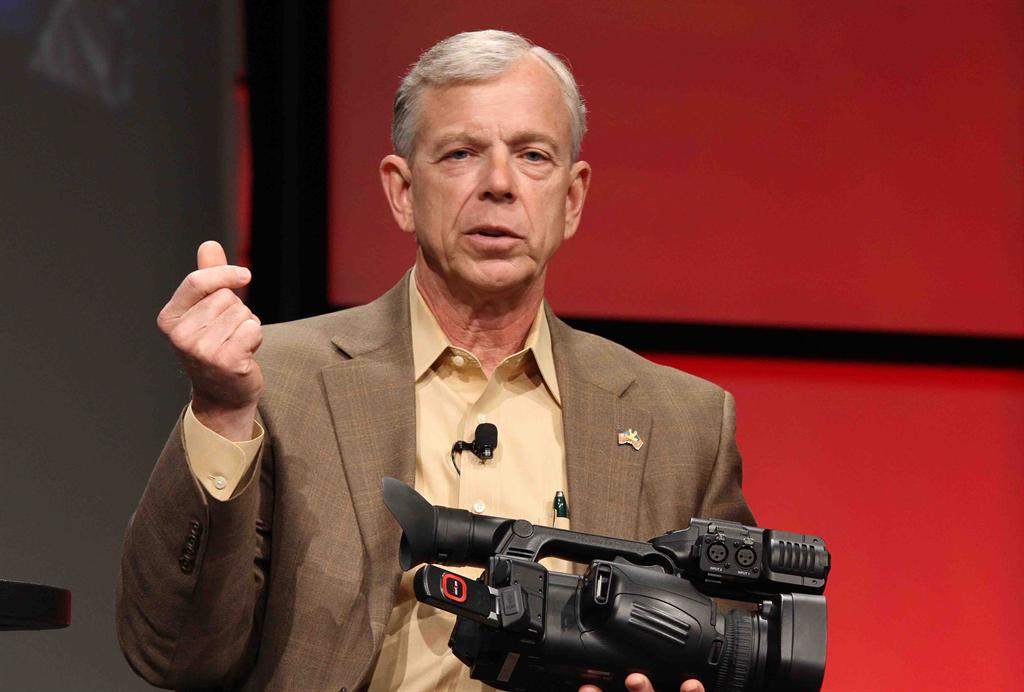2013 NAB Show Anticipated Trends

VerizonCommunications CEO Lowell McAdam pointed to JVC’s GY-HM650 2.0 ProHD mobilenews camera at an NAB Show session to demonstrate how broadcasters can use Verizon’s LTE technology to enhance newsgathering capabilities
LAS VEGAS—When you look in the rear view mirror of the annual NAB Show, there ought to be a collection of both the past and future: an honest look at what hasn’t worked; what’s awaiting the industry a few months down the line; what’s coming 10 years into the future.
In this way, this year’s show didn’t disappoint. It offered a mostly honest assessment of where the industry finds itself—where it has stumbled, and where it’s moving now.
“We do our best to anticipate the trends that will be at the top of our minds for the industry and those that will carry over,” said Chris Brown, executive vice president of conventions for NAB. “It is never an easy task and to some extent we have to take some chances and hope that our efforts will spur productive interchange.”
TECH IN FOCUS
The forces that helped steer this year’s conversation: 4K, cloud technologies, workflow advancements and new ENG options were among the headlines.
Add to that list a new batch of over-the-top and second-screen opportunities that are changing the way the industry distributes its content. What makes OTT services appealing to traditional broadcasters and networks is a double-edged gift: strong consumer demand coupled with a growing proliferation of connected devices. The resulting revenue opportunity is hard to ignore.
“This [could be] a huge revenue opportunity for content owners and distributors,” said Jennifer Baisch, senior director of product and services marketing for iStreamPlanet, based in Las Vegas.
The next step for the industry is finding the right technology to distribute and support OTT services affordably and reliably.
“One of the biggest challenges for content owners and distributors is how to scale the technology that’s needed to bring more content, including live broadcast channels, to multiple screens,” Baisch added.
This technology mirrors another wide-ranging phenomenon: a growing interest across the industry in moving from a hardware infrastructure setup to cloud-based solutions. Supporters tout the benefits of cloud technology, of being able to offer an elastic scalability that can drive down the cost of delivering content. The phrase that arises again and again: increasing efficiency while decreasing costs. At the show, Sony announced the formation of a new subsidiary called Media Cloud Services designed to give professionals a “virtual workspace” to store, share and manipulate content via the company’s Ci scalable cloud platform. “We designed Ci as a media-focused could platform that can enhance and streamline traditional production workflows,” said Naomi Climer, president of the new organization.
The show floor itself was covered with exhibitors offering versions of the same, like Telestream with its Vantage Cloud transcoding solution. “It gives you the advantage of having the equipment without needing onsite hardware,” said John Pallett, director of product marketing for Telestream.

The biggest technological buzz at the show was undoubtedly the buzz over 4K Ultra HD displays. With NHK whetting appetites by demo-ing a live 8K broadcast in its booth, the prevalence of 4K technologies were found in sessions, panel discussions, booth displays and random lunch conversations. Quite regardless of the fact that nary a consumer owns a UHDTV set, the industry is abuzz about the possibilities.
“I think 4K is extremely important for broadcasters to start using in their plant, in their systems, in their mobile trucks,” said Stan Moot, vice president of business development for Harris Broadcast. “I don’t think beyond a few boutique channels that we’ll see 4K transmitted for some time. But it’s important for people to push 4K in the facility. You create a future-proof environment so we can cascade multiple channels tighter with routers internally in the plant.”
Despite the excitement, the technical and bandwidth challenges are beckoning. “There is the ‘chicken and egg’ issue of producing 4K content to feed 4K consumer devices,” Brown admits. “Layer that on the issue of consumer adoption and the typical price-demand curve that flows from any new technology introduction.”
HYBRID ENG
The show also saw a spike in interest from behind the scenes. A number of companies showcased new hybrid satellite/bonded cellular solutions for SNG and ENG transmissions. LiveU, for one, showcased an integrated antenna solution for mobile trucks that takes advantage of existing satellite connectivity and cellular reception. The Xtender gives newscasters the flexibility to use cellular connectivity as part of their typical newsgathering operation, a bonded mix of cellular and satellite connectivity.
“This hybrid solution offers the ultimate flexibility for news teams on the move,” said Samuel Wasserman, CEO of the Hackensack, N.J.-based company. In a different configuration, the antenna can also be connected to backpack and handheld units to offer “greater resiliency, performance and flexibility in crowded demonstrations, sports stadiums and other extreme scenarios,” he said.
CBS station KPIX in San Francisco recently announced it purchased a hybrid-transmission system from Dejero. The LIVE+ VSET is a 1 RU vehicle-mount transmitter that takes advantage of available connection types, be they cellular, satellite or microwave. This hybrid approach enables newsgatherers “to go live from traditional as well as modern technologies from the same truck, even while driving,” said Bran Cram, CEO of Dejero in Kitchener, Ontario. The technology can be put to good use in San Francisco’s rainy climate, where rain can affect the strength of Ka-band satellite bandwidth connection. The hybrid technology automatically senses the drop in bandwidth and continues a transmission over a cellular network.
WHAT’S NEXT?
The show touched on a variety of other issues—from social media and 3D to mobile TV—the latter of which remains a much-anticipated solution. A next-generation platform, whatever final form it takes, is what the industry needs.
“Television broadcasting needs to drive for a new and more capable next-gen platform,” said Mark Aitken, vice president of advanced technology at Sinclair Broadcast. For many broadcasters and for the networks, it’s 4K; for others it’s the promise of mobile TV.
“We need a platform that can compete in every important way with our real competition: the wireless phone companies,” he said. “We don’t really have that. You might ask ‘don’t we have mobile DTV today?” and the answer would be “we have a standard; it’s a start.’ But for a variety of technical and rights-related reasons, it is not yet a business.”
That perspective means we have another 11 months to decide if we should be looking in the rear view mirror, or perhaps looking ahead.
Next year’s show takes place in Las Vegas, April 7–10, 2014
Get the TV Tech Newsletter
The professional video industry's #1 source for news, trends and product and tech information. Sign up below.
Susan Ashworth is the former editor of TV Technology. In addition to her work covering the broadcast television industry, she has served as editor of two housing finance magazines and written about topics as varied as education, radio, chess, music and sports. Outside of her life as a writer, she recently served as president of a local nonprofit organization supporting girls in baseball.

